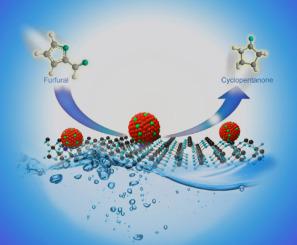Chinese Journal of Catalysis ( IF 16.5 ) Pub Date : 2021-09-15 , DOI: 10.1016/s1872-2067(21)63842-1 Shujing Zhang 1, 2, 3 , Hong Ma 1, 3 , Yuxia Sun 1, 2, 3 , Xin Liu 1, 2, 3 , Meiyun Zhang 1, 2, 3 , Yang Luo 1, 2, 3 , Jin Gao 1, 3 , Jie Xu 1, 3

|
Tandem catalysis for the hydrogenation rearrangement of furfural (FA) provides an attractive solution for manufacturing cyclopentanone (CPO) from renewable biomass resources. The CuNi/Al-MCM-41 catalyst was synthesized and afforded excellent catalytic performance with 99.0% conversion and 97.7% selectivity to CPO in a near-neutral solution under 2.0 MPa H2 at 160 °C for 5 h, much higher than those on other molecular sieve supports including MCM-41, SBA-15, HY, and ZSM-5. A small amount of Al highly dispersed in MCM-41 plays an anchoring role and ensures the formation of highly dispersed CuNi bimetallic nanoparticles (NPs). The remarkably improved catalytic performance may be attributed to the bimetallic synergistic and charge transfer effects. In addition, the initial FA concentration and the aqueous system pH required precise control to minimize polymerization and achieve high selectivity of CPO. Fourier transform infrared spectroscopy and mass spectra results indicated that polymerization was sensitive to pH values. Under acidic conditions, FA and intermediate furfuryl alcohol polymerize, while the intermediate 4-hydroxy-2-cyclopentenone mainly polymerizes under alkaline conditions, blocking the cascade of multiple reactions. Therefore, near-neutral conditions are most suitable for minimizing the impact of polymerization. This study provides a useful solution for the current universal problems of polymerization side reactions and low carbon balance for biomass conversion.
中文翻译:

CuNi双金属催化剂在水中选择性串联氢化和重排糠醛为环戊酮
用于糠醛 (FA) 加氢重排的串联催化为从可再生生物质资源制造环戊酮 (CPO) 提供了一种有吸引力的解决方案。合成了 CuNi/Al-MCM-41 催化剂并在 2.0 MPa H 2的近中性溶液中提供了优异的催化性能,转化率为 99.0%,对 CPO 的选择性为 97.7%在 160 °C 下 5 h,远高于其他分子筛载体,包括 MCM-41、SBA-15、HY 和 ZSM-5。少量高度分散在 MCM-41 中的 Al 起到锚定作用,并确保形成高度分散的 CuNi 双金属纳米粒子 (NPs)。显着改善的催化性能可能归因于双金属协同效应和电荷转移效应。此外,初始 FA 浓度和水性体系 pH 值需要精确控制,以最大限度地减少聚合并实现 CPO 的高选择性。傅里叶变换红外光谱和质谱结果表明聚合反应对 pH 值敏感。在酸性条件下,FA与中间体糠醇聚合,而中间体4-羟基-2-环戊烯酮主要在碱性条件下聚合,阻断多个反应的级联反应。因此,接近中性的条件最适合最小化聚合的影响。该研究为目前普遍存在的聚合副反应和生物质转化低碳平衡问题提供了有用的解决方案。


























 京公网安备 11010802027423号
京公网安备 11010802027423号